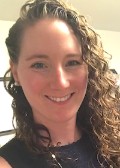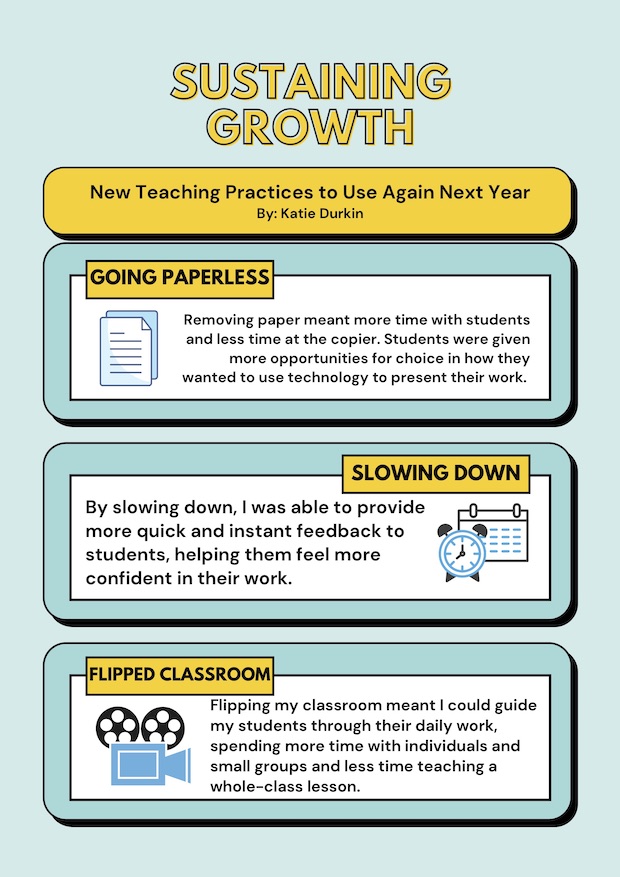3 Pandemic Practices I’ll Be Taking Forward
By Katie Durkin
 Even though the school year may be coming to an end, I always like to think of it as a new beginning, a chance to reflect on the past year’s successes and prepare for continued growth.
Even though the school year may be coming to an end, I always like to think of it as a new beginning, a chance to reflect on the past year’s successes and prepare for continued growth.
For many teachers and students, this year has been challenging as we figured out how to navigate learning during a global pandemic, and I’m sure there are some things we’d all like to leave behind.
Yet there are many positives I will be taking with me into school year 2021-2022. In particular, three practices were new for me this year that will remain a part of my work moving forward. Each one helped me connect more with my students and their learning.
They included (1) going paperless; (2) slowing down the curriculum to provide more feedback to students, and (3) using the Flipped Classroom model of instruction.
1. Going paperless: Replacing time at the copier with teaching
It has always been a goal of mine to make my classroom paperless. Year after year, I would spend hours at the copying machine, painstakingly clearing paper jams, dreaming about how I could make my classroom more green. This year, based upon the COVID-19 mitigation strategies, I didn’t have a choice since we weren’t allowed to use paper without quarantine protocols.

Some book discussions happened virtually through Flipgrid, and I was able to track students’ thinking about their reading rather than trying to run around the room listening to every conversation I could in one period.
While these mitigation strategies were frustrating to some, it freed up my students to make choices about how they wanted to present their work. It also allowed me to leave the school building every day with just my laptop in tow since everything was saved on Google Drive.
This year my students lost less work, and I was able to get them feedback faster than I ever had before. I spent more time lesson planning and assessing and less time at the copy machine.
Next year, I plan to continue being paperless. I believe this practice will not only help the environment but will also help students be better prepared for an ever-evolving paperless world.
2. Fewer mini-lessons and more effective feedback
Being paperless also meant I was able to assess more and grade less (Gallagher and Kittle, 2018, p. 19), slowing down my usual breakneck rush to get through the curriculum. That fast pace – always looking ahead – frequently didn’t allow me to give students feedback on the work they were currently doing.
In years past, I would teach at least four mini-lessons a week, one lesson for Monday through Thursday, reserving Friday as a chance for students to catch up and free-read. These assignments were meant to be started in class and finished each night. In practice, students were often taking a significant amount of work home because there wasn’t enough time in my 40-minute period to do the mini-lesson, allow time for individual work, and complete conferences.
This year, I only taught two major mini-lessons each week – with the first day as an introduction to the work and the second an opportunity to complete an online discussion. These online discussions related to the assignments and were ways for me to assess students’ efforts and understanding, and to provide quick feedback.
The students have relayed they have found this feedback on discussions invaluable because they felt more confident in their work, and they knew they were on the right track when completing assignments.
By slowing down the pace, students also did not have to complete as much work at home. They were able to start and finish my assignments in school, and the only homework they had was watching my flip videos, the final sustainable practice I plan to keep next year.
3. Flipping the classroom (with Screencastify) works!
Even with a focus on being paperless, and slowing learning down, I believe my biggest success was implementing the Flipped Classroom model this year. I learned about Flipped Classroom years ago, and, like going paperless, had always wanted to do it but really didn’t know how.
Flipped Classroom reverses the traditional model of instruction with students learning the lesson at home for the next day’s class, sometimes via video, then practicing the lesson in school with the teacher answering questions and providing feedback (van Alten, Phielix, Janssen, & Kester, 2020).
Starting the year in hybrid teaching, with half my students on Zoom and half in the classroom, meant I needed to find a model of teaching that would give me time to work directly with all the students – whatever their location – while also teaching the curriculum. Flipped Classroom seemed like it might be a good solution, and it was.
The major problem holding me back in the past was how to make the videos. Screencastify became my best friend this year. It is an online video creation platform that allows you to share your screen while also projecting a video of the creator (in this case, the teacher).
This “inset” feature was important for me because I wanted my students to see my face in the videos I made, knowing I would be wearing a mask during the school day.
Flipped Classroom did require a shift in my lesson planning. I started planning each week rather than day-by-day so I could make sure my videos were prepared ahead of time.
Here’s a book talk video Katie made for her classes
Because of Flipped Classroom’s model, students are expected to watch a video each night for homework and then do their written work in the classroom with support from the teacher. This was a shift for the students too, and I noticed early on many of my students weren’t watching the videos. So, I added secret messages to every video I did.
These secret messages were a way for me to see which students had watched the videos. More importantly, it was a great way for me to make connections with my students. Each secret message asked the students to take action or answer a question in their work for the next day. Typically, they were asked to answer a question or add a picture to their online Reader’s Notebooks.
While this may have started out as a way for me to see who was doing their homework, it turned into a way for me to learn more about my students than ever before. The questions started out asking about their favorite foods, sports, activities, etc., but as the year went on I needed to get creative, asking students about whether or not they would travel to Mars or what exotic animal they would want to keep as their pet and why.
It was a way for me to connect with my classes and learn about their likes, dislikes, and curiosities on a deeper level. I was able to have more conversations, not about the content of my curriculum, but rather about my students as human beings.
As a bonus, my students really liked discussing the secret messages the next day in class, bypassing the idea of it being a secret, but making it all the more fun.
Classroom practices that put my students’ needs first
This year, it often felt like I was thrust into the deep end of a pool, constantly treading water. But reflecting on this year’s work, I can say the water feels great, and I can’t wait to dive in again next year.
This year was an opportunity for teachers and students to solve problems, but more importantly, it was a year of growth in our goal to become self-starting, confident learners. Through my work this year, I was able to discover three sustainable practices that put my students’ needs first and that I can carry into 2021-22.
I believe this idea of “pandemic pluses” is a conversation all teachers need to have at the end of this year, and I would love to hear what new and improved practices you plan to carry over into next year. Using the comment section below – or the twitter hashtag #EDsustaininggrowth – join me to explore how we can all continue to grow together.
References
Gallagher, K., & Kittle, P. (2018). 180 Days: Two teachers and the quest to engage and empower adolescents. Heinemann.
van Alten, D. C. D., Phielix, C., Janssen, J., & Kester, L. (2020). Self-regulated learning support in flipped learning videos enhances learning outcomes. Computers & Education, 158.
Katie Durkin (@kmerz610) has been teaching English Language Arts to middle school students for a decade and currently teaches 7th grade Reading Workshop at public Middlebrook School in Wilton, Connecticut.
Katie is a zealous reader of middle grades and young adult books and enjoys sharing her love and passion for reading with her students. She is a doctoral student at Northeastern University studying the impact of classroom libraries on middle school students’ reading engagement. She is the 2020 recipient of the Edwyna Wheadon Postgraduate Training Scholarship from the National Council of Teachers of English.




































Wow! I loved your ideas as well as your example book talk. Thanks for sharing your learning, your resources, and your successful practices!